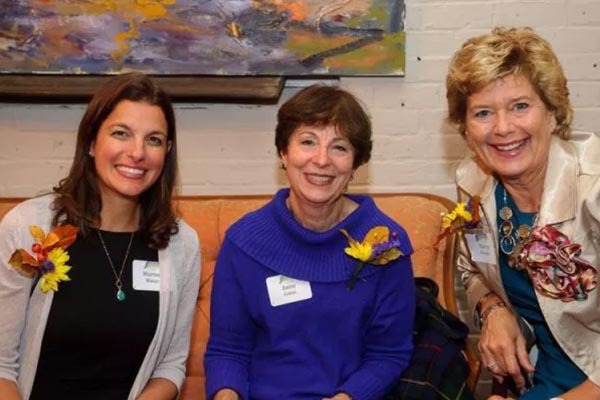Women form their own Giving Circle
BY TRACEY O’SHAUGHNESSY REPUBLICAN-AMERICAN
It wasn’t enough to write a check. Nor was it enough to stipulate that a donation would support programs that benefit women. The women who came together to create the Women’s Giving Circle wanted to get their hands dirty. They wanted to understand the lay of the land. They wanted to fully grasp the grantmaking process. They wanted to get more bang for their buck.
So, in 2017, a group of women eager to support other women, created the Women’s Giving Circle, a nonprofit under the auspices of the Connecticut Community Foundation.
Members modeled their giving circle on others around the country in which groups of women, eager to volunteer and support their local community, will pool their money and discuss strategies to donate effectively.
“Just because there is a need doesn’t mean you throw money at it,” said Kathy Bower, the group’s chairwoman. “This is a way of thinking that is not just ‘I want to support an entity because I heard that is a good entity to support.’ You want to understand that on a deeper level. You want to make sure your giving is intelligent.”
In its first year the Giving Circle raised $34,000 from participants. “That chunk will have more impact than tiny pieces (of donations) in multiple directions,” said Bower, an attorney from Southbury.
Giving Circles work by setting a high membership level – $500 in this case – and targeting particular areas of concern. By pooling their money to make grants to local non-profits, the Giving Circle can have a larger and more immediate impact.
“It’s a whole different feel than writing a check,” said said Sharon Randall, 42, a corporate attorney from Middlebury, noting the lack of administrative costs. “You are involved understanding the organizations that you are trying to help.This money from the Giving Circle goes into a pot and we give it all away.” Since their inception 10 years ago, the number of women’s circles nationally has tripled. The amount of money the groups donated has soared from $65 million to $1.29 billion in the last 10 years, said Debra Mesch, professor of philanthropic studies at Indiana University Lilly Family School of Philanthropy. “It’s just exploded,” said Mesch.
Her research has shown that women prefer giving in social circles “where they can pool their money, where they can learn from one another and come to consensus in the way that they like, it’s a mode of giving” that resonates with the way women are socialized, she said.
“It’s not a staff-driven thing. It’s not a foundation-driven thing,” said Bower. “We are the ones who make the decisions.You have so much more of an investment in it when you are making the decisions.” The group invites speakers from the world of philanthropic giving and non-profits. Many of the more than 60 members are personally connected to the institutions they support.
Randall, now a corporate attorney, grew up in the Baldwin Street area of Waterbury and wanted to help those in need, as she once was. “You grow up in a more economically disadvantaged area, you know what needs to happen. There are places in Waterbury that need help. If you grow up in and around that, you want to do that…. It was not such a bad thing to grow up on Baldwin Street. People have a misconception. There were so many organizations that pulled us together. And when you get older, you realize that doesn’t just happen.”
Mesch, the Eileen Lamb O’Gara Chair in women’s fundraising, said her research has found that the women in giving circles are “much more invested in the nonprofit sector, they are more educated in the nonprofit circle and they are much likely to give more.” And in the last four or five decades, they have come into more wealth. Between 2010 and 2015 private wealth held by women grew from $34 trillion to $51 trillion, according to the Boston Consulting Group. By 2020 women are expected to hold $72 trillion, or 32 percent of all private wealth.
Moreover, most of the private wealth that will change hands in the coming decades is likely to go to women because women inherit twice, Mesch noted, once from their parents and once from their husbands, who typically die before their wives.
Bowers, who joined with her three daughters, said she relished the chance to hear stories from other women who have faced barriers. The Southbury mother, who graduated from law school in 1987, said she faced many gender barriers as a young female lawyer in the 1980s. “It was an all-boys club, including the bench,” said Bower, who worked in a Manhattan law office after college. She said there were few resources for women facing discrimination.
“Every single day it felt like there were obstacles,” she said, noting that in the legal profession, women face a 53 percent gender gap, far worse than in other professions. She said meeting with other women to support one another “feels amazing. It feels amazing to share that with our daughters. We donated $500 as a family … It feels bigger than our $500 would ever have felt had we just made a single donation.”
Julie Loughran, president and CEO of Connecticut Community Foundation, said her research demonstrated that women are generous but give differently. “Women often like to pool their resources and give in a more hands-on way,” she said, adding that she supported the organization not just to increase donations “but also so that they could learn together, work together to decide how to spend their pooled fund.”
The group meets four times a year. During their meetings, they listen to speakers, hear from people who are applying for grants and network among one another.
The organization expects to increase in members and donations. “Women have come into a lot of wealth,” said Loughran. “There is a lot of money that women have, for the first time in history, that is all their own where they get to choose where it goes. It will accelerate. You have always had women who’ve inherited money. Now you have a couple of generations of women who have also generated their own wealth.”


